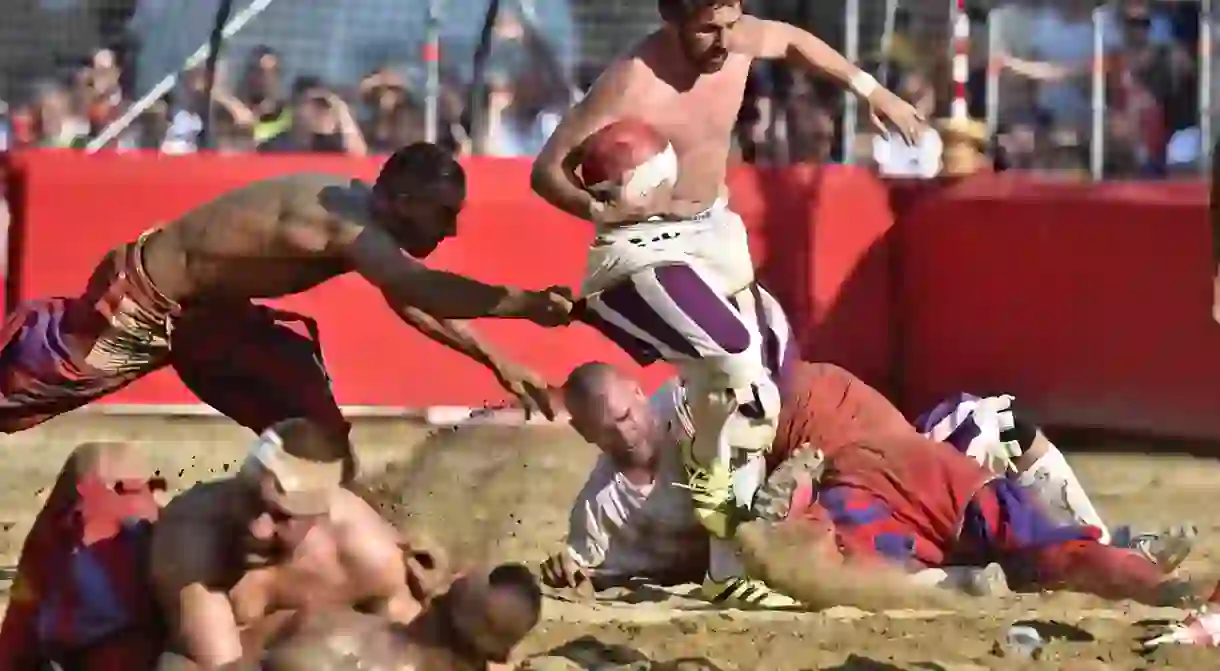Fiorentina's New Kits Honour the City's Historic Sport

The design, and subsequent release, of a football team’s latest kit can often be a somewhat dull affair, with very little effort or thought put into heritage or identity. Fiorentina, however, have paid the perfect tribute to a sport they can truly call their own.
Traditionally, most teams would have one alternative kit, and more recently a third option has become the norm (ultimately for commercial reasons), this year Fiorentina added a fourth. To have a home shirt, and four away options, would ordinarily be beyond excessive. But, Fiorentina’s latest launch made clear the club’s reasoning: for each away kit to represent one of Florence’s four historical quarters, and, to highlight the point, they positioned striker Federico Chiesa donning the new home jersey of his club, flanked by fans representing each district.

While the home kit remains, and will always be, purple, the club have released a white, red, blue and green set of shirts which correspond to the colours of the brutal, but beautifully brilliant, calcio storico. This is Florence’s football, where teams are centred around the four historical neighbourhoods. Fiorentina’s kit honours the Azzurri (blue) of Santa Croce, the Rossi (red) of Santa Maria Novella, the Bianchi (white) of Santo Spirito, and the Verdi (green) of San Giovanni.
Once a year Florence comes to a standstill for the sport. Its almost gladiatorial version of football is played in the city’s central Piazza Santa Croce, where two teams, of 27 players each, must get a ball over a four foot fence (1.2m) at either end of the pitch. Players are permitted to use aggressive methods to try and score, meaning that punching, head-butting and wrestling are commonplace, with blood and sweat found amid the sand on the Piazza’s floor. The sport is uncompromisingly brutal.
Similar to Il Palio, Siena’s incredible horse race, this Tuscan city has managed to preserve an event they’ve held dear for hundreds of years to the point whereby today it signifies local pride, pageantry and identity. While it may be easy to accuse Fiorentina’s decision as simply a ploy to shift more shirts, the truth is part of a wider belief that pays tribute to local identity and pride, as while Florentines believe their sport to be the best, each quarter believes they’re the best at it.
Speaking to The Gentleman Ultra, calciante (or competitor), Lorenzo Taddeucci explains: ‘The Santo Spirito area is the last real Florentine neighbourhood, so there is more connection with the team. A lot of my team-mates live and work in the neighbourhood so it gives us the “extra factor”. I’m lucky to play for the Bianchi, we are like a family so it’s a natural thing for me.’
The notion of playing for the ‘last real Florentine neighbourhood’ is more than simple boasting. Florence has undergone, and continues to go through, a process of gentrification, with foreign investment in sought after properties. As a result, large amounts of Florentines have been priced out of areas their families have lived in for decades, forced to move out of the city and into the surrounding area.
While the city evolves as a result of 21st century realities, its sport – virtually untouched since its inception over 500 years ago – remains constant. The rivalries between the districts are very real, but each fight to give something back to their city and preserve what they hold dear.
There will undoubtedly be huge amounts of pride swelling when La Viola step onto the pitch in any of the colours. There will be no internal squabbling or petty battles when one quarter’s colours are being played in, and others aren’t. As explained in Copa 90’s short film on the sport, ‘In calcio storico there is mutual respect for all four colours. On June 24 they divide themselves, but at the end they are always united by one colour. This purple brings us together and Fiorentina for Florence becomes the priority.’













